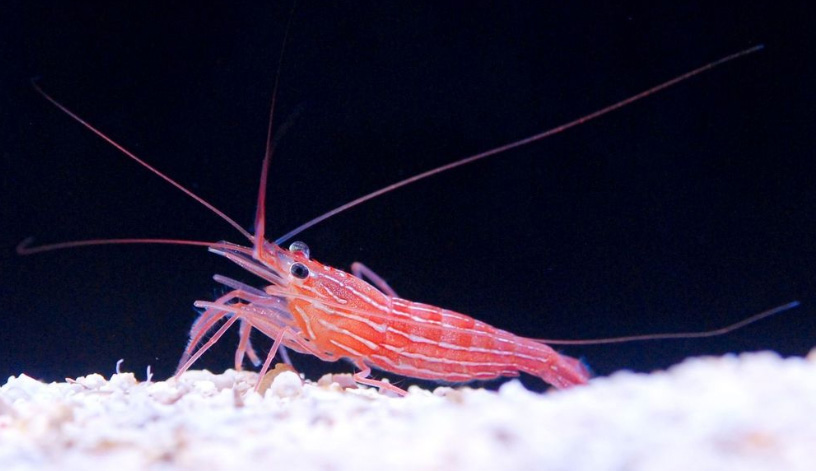Breeding Peppermint Shrimp – The complete guide
Featured image credit: www.qualitymarine.com
Table of Contents
Most all Peppermint shrimp in the aquarium trade are currently wild-caught. To reduce the impact we can help out by breeding our own shrimp in captivity. They are highly sought after for their aiptasia control by reefers and can bring in a pretty penny to help fund your hobby. I guarantee any LFS will willingly buy all the Peppermint shrimp you can bring.
Before we dive in I have to give credit to April Kirkendoll and her book “How To Raise & Train Your Peppermint Shrimp“. I gained a lot of technical knowledge from this book while I was breeding shrimp myself. If you are serious about breeding Peppermint shrimp or other marine shrimp you should pick up a copy of her book. It is a very easy read.
Are Peppermint shrimp easy to breed
Yes. They are very easy to breed. As long as you have two shrimp they will breed for you in no time. Most likely you will notice your shrimp are pregnant within a month or even less.
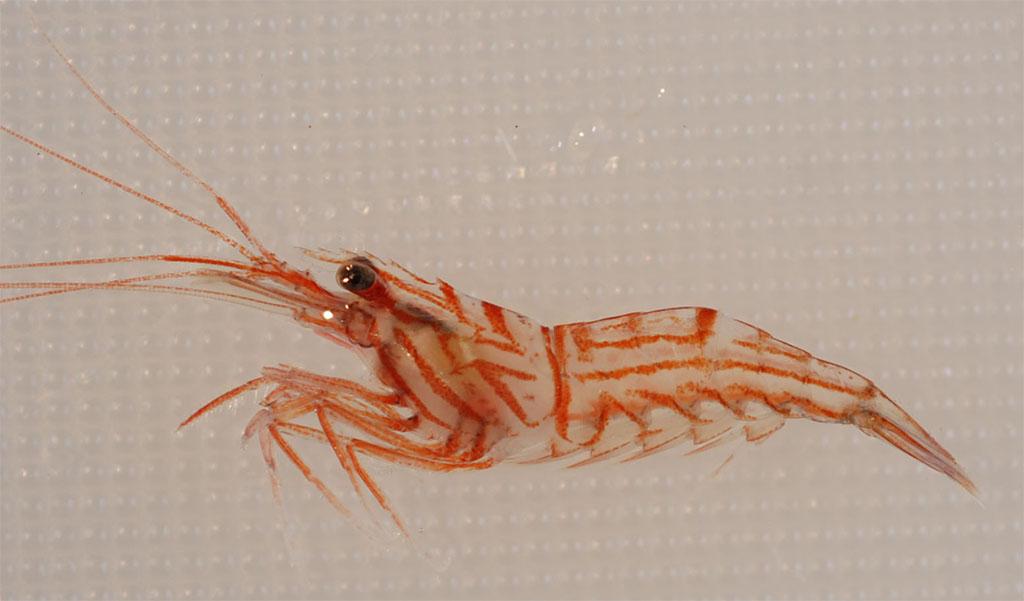
Selecting the right shrimp to breed
There are several species of Peppermint shrimp, but for the reef aquarium hobby, there are only two main species we will be dealing with.
lysmata wurdemanni
You want to have these in your tank and breed them as they are less likely to develop a taste for your corals.
lysmata boggessi
These will eat aiptasia just as well as lysmata wurdemanni but lysmata boggessi has a reputation for going after corals once the aiptasia is gone. If you feed them very well daily they are less likely to have an appetite for your corals but it’s still no guarantee with them.
Peppermint shrimp for sale
Your local LFS is the best place to buy them, but if they are out of stock, Quality Marine is a great place to buy them.
How do they mate
When mating, the shrimp playing the role of the male will swing underneath the newly-molted shrimp and they will mate. This process only takes a few seconds, and the shrimp is pregnant.
Peppermint shrimp are simultaneous hermaphrodites. This means they have both reproductive organs. You only need two shrimp and they will mate in no time. Usually, both shrimp will end up carrying eggs at the same time.
How can you tell if a shrimp is male or female
Peppermint shrimp are simultaneous hermaphrodites. They have both reproductive organs.
How many babies do they have
They can have hundreds of eggs at a time, upwards of around 300 eggs.
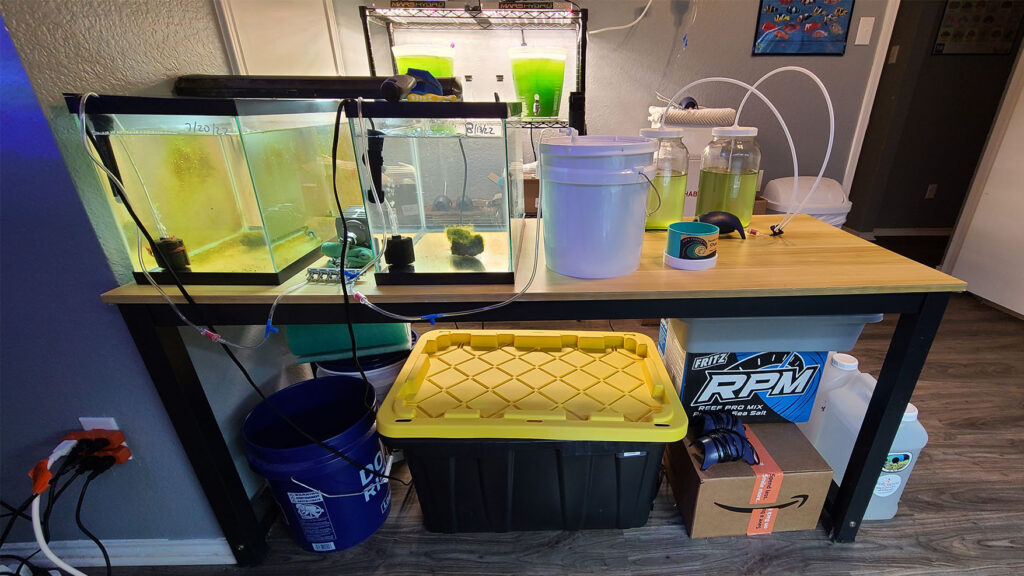
Setting up the parent tank
A 10-gallon aquarium from Petco will be the perfect size holding tank for adult Peppermint shrimp. You can also just take the shrimp out of your main aquarium once you see that they have eggs if you don’t want to set up a seperate tank for them.
Next, you will need to add a filter sponge connected to an air pump for biological filtration and flow, a small 50-watt heater, and small light like this clamp-on desk light to see when they have eggs.
I also like to add a lid to the aquarium so the water droplets that are produced from the filter sponge and air pump do not make a mess. The proper lid for a 10-gallon aquarium is sometimes hard to find at your local Petco or Petsmart, so you can use a piece of clear ¼” acrylic cut to size for a lid.
If you have a rock that has aiptasia on it, you can put this in their new tank and this will seed the sponge filter with beneficial bacteria. The tank will be instantly cycled, so you can add your shrimp right away. If you want to pull the rock out, wait at least a month or two to ensure that the filter sponge is well-seeded with bacteria.
If you do not have a rock from your main tank to add to the shrimp tank, you will need to make sure the tank is cycled well before adding any shrimp to it as ammonia will kill them pretty quickly.
How many shrimp can you have in one tank
For a 10-gallon aquarium, I would add no more than 3-5 shrimp. You will want to make sure they all have plenty of hiding spaces such as a filter sponge and live rocks.
Feeding adult shrimp
You will want to feed your adult shrimp daily with plenty of food. I feed a small chunk of LRS Fish Frenzy each day. If they do not get enough food, they will go after your corals and even turn cannibalistic and eat each other.
How long do you have to wait for eggs
Typically you should not have to wait much longer than two to three weeks and your shrimp will become pregnant. Once the shrimp feel safe and comfortable in their new home they will breed on their own. Make sure to feed them really well and do regular water changes to keep the nutrients low in their tank.
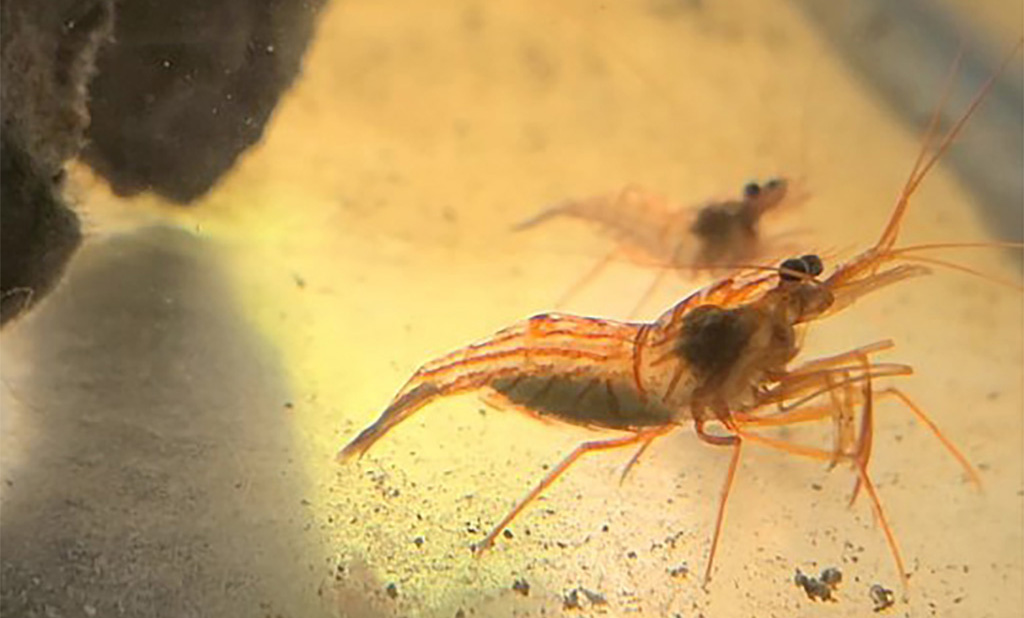
What does a pregnant shrimp look like
A pregnant shrimp’s stomach area will appear dark in color. These are eggs. If you have a macro lens and a DSLR or mirrorless camera you can zoom in close enough to clearly see the individual eggs. A cell phone camera will work too but the photo will not be as clear.
Setting up the larval rearing tank
This should also be a 10-gallon aquarium. You will want to set up the shrimp larval rearing tank with a sponge filter and an air pump, a small 50-watt heater, a lid, and a small clamp-on light. You do not want to add any live rock as this will get in the way while you are doing water changes and cleaning the bottom glass of the tank. Make sure the larval tank is cycled prior to trying to raise Peppermint shrimp in this tank.
Quick tip
Once I see that a shrimp is pregnant I will immediately add only one shrimp to the rearing tank. Once the shrimp releases the larvae in this larval tank you will simply pull the adult shrimp out and place it back into the parent tank. If you leave the adult shrimp in too long after it gives birth, it will eat the babies.
How long until the eggs hatch
Rearing time is generally around 12-20 or so days as long as the shrimp feels safe and comfortable in its environment. If you move it from the parent tank to the larval-rearing tank well into its pregnancy it may hold onto its eggs for longer. Make sure you move the adult shrimp as soon as you notice it’s pregnant.
They are livebearers
The eggs will develop inside the shrimp, but once the eggs grow into tiny larval shrimp, the adult shrimp will molt and release its live babies into the water.
Catching the larvae
If you do not move the adult shrimp into a larval-rearing tank soon enough you can still catch the majority of the newly hatched babies by using Vossen’s Larval trap, a very small light source, and an air pump.
The light will attract the larvae, and the air pump will help push the babies into the trap.
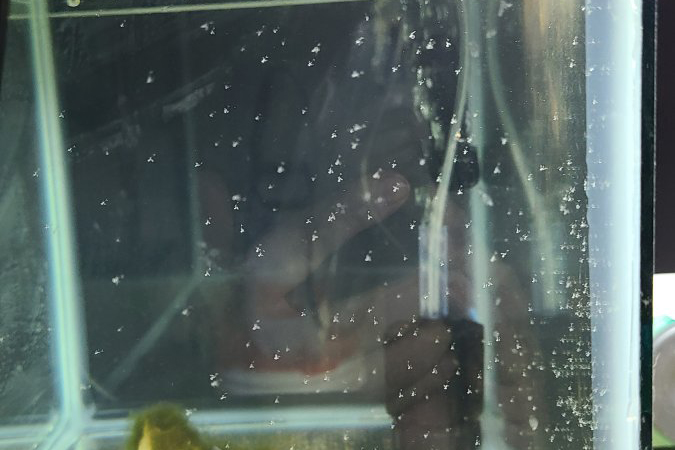
Raising the larve
Feeding the larvae
Larvae will need to be fed live baby brine shrimp daily.
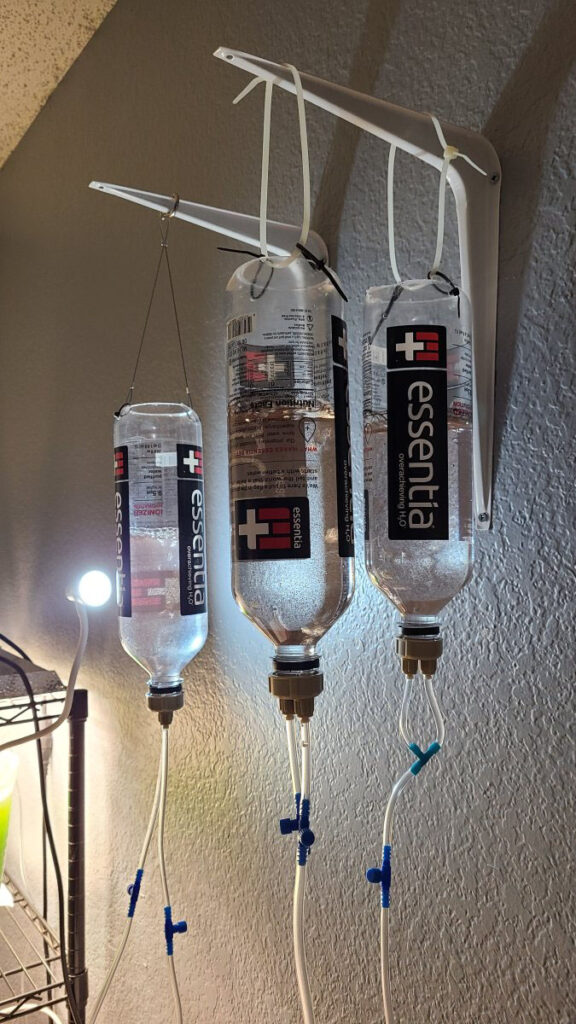
Brine Shrimp Hatchery
This is my brine shrimp hatchery I made using an Essentia brand water bottle. I did not come up with the idea myself. I found a video on YouTube, but cannot find the video I learned this from. If I come across the video again I will give the proper credit.

Phytoplankton Culturing
You will also need to either culture your own phytoplankton or buy it. You will need to feed the brine shrimp phytoplankton so they can stay alive longer than a day or two.
Water changes
Maintaining a clean tank is very important when raising shrimp larvae. You will have to do a water change roughly twice a week and clean the bottom glass of brine detritus, dead larvae, dead brine shrimp, and other organic matter.
How to clean the bottom glass
The method I use to clean the bottom glass is I get a 5-gallon bucket, an airline hose, and a rigid airline tubing and manually siphon out the gunk on the bottom glass until it’s all clean. I do this at least once a week. If I can manage it I do it twice a week.
Feeding guide
- Day 1-14 – Feed newly hatched brine shrimp
- Day 7-21 – Feed week-old brine shrimp (~ 1mm)
- Day 16 – 30 – Feed juvenile brine shrimp (1-5 mm)
- Day 18 – 35 – Feed Adult brine shrimp (>5 mm)
Brine shrimp ages and sizes should overlap as Peppermint shrimp grow.
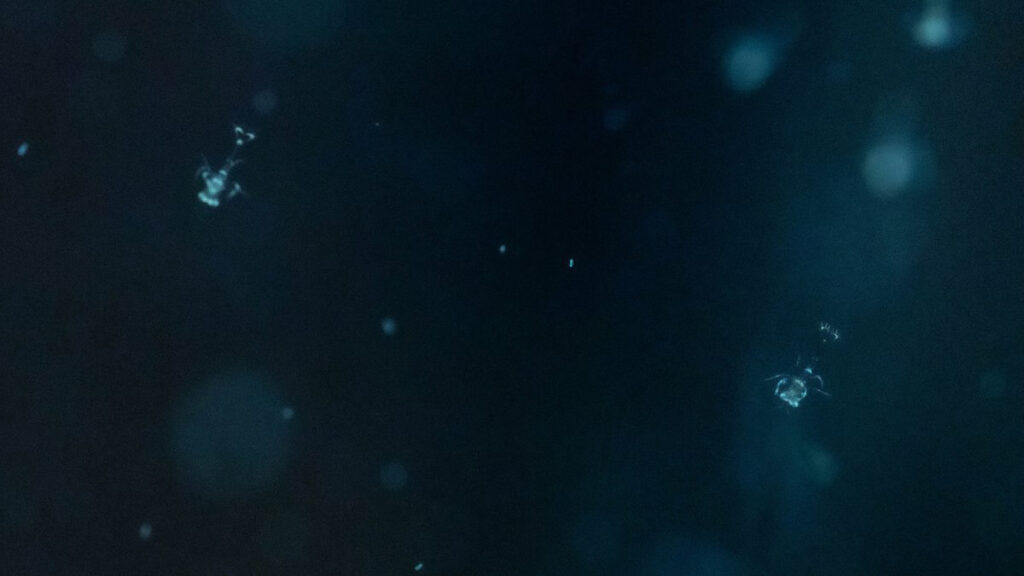
From egg to adult shrimp
Shrimp will molt several times as they grow larger every day. Molting is very hard on young shrimp and you will lose quite a few shrimp due to this process. It takes a lot of energy to molt and if the shrimp aren’t eating well or are healthy enough they will die. It is normal for only about 10% of the eggs to make it to a full-grown adults.
Larval growth stages
- Day 1 – 2mm in size
- Day 4-5 – 3mm in size
- Day 6-7 – 5 mm in size
- Week 4-5 – 2 cm in size (from the tip of spear legs to antennae)
- Week 5-12 – the shrimp will continue to get larger each week until they reach around 2-3 inches, then they will be their full adult size.
Lifespan
Peppermint shrimp can live up to two years in captivity.
Are Peppermint shrimp reef safe
They are reef safe with caution. If they have aiptasia to eat, they will generally only eat them. If there is no aiptasia and they are not fed well each day, they may develop a taste for your corals or even turn cannibalistic and eat eachother.
I have found that they tend to go for meaty corals such as Acans, Lobos, Scolys, Acanthophyllia, etc. Also, lysmata wurdemanni are less likely to eat corals than lysmata boggessi.
Videos showing the different development stages
Final thoughts
Peppermint shrimp are a very valuable resource to our hobby. We need to do everything we can to preserve them in the wild so we will always have them. Breeding Peppermint shrimp is not the easiest, but it’s easier than breeding some fish. With just a little effort and knowledge you can breed your own Peppermint shrimp to keep or sell to your LFS.


